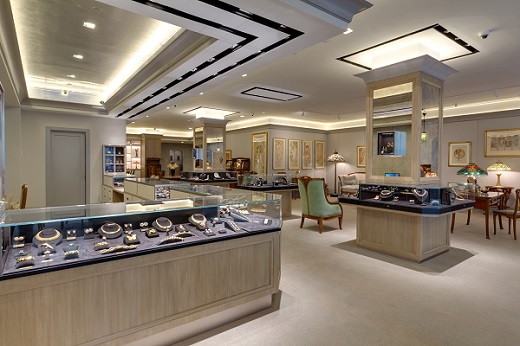|
|
Macklowe Gallery Move Gives It Room to Grow
Dec 19, 2017 4:12 AM
By Phyllis Schiller
|
|
|

RAPAPORT... Macklowe
Gallery’s move to a more spacious venue in November was “a no-brainer,”
according to second-generation president Benjamin Macklowe. The New York City
gallery now has “more opportunity to tell our entire story, including jewelry,
Art Nouveau pieces and the artwork of Louis Comfort Tiffany,” he says.
Founded by Lloyd
and Barbara Macklowe in 1971 — Benjamin joined in 1994 — the family-owned
business displays a carefully curated array of decorative art and adornments
from various periods. After spending more than 40 years on New York’s Madison
Avenue, it has upgraded from 20 feet of frontage to 135 feet on the corner of
Park Avenue and 57th Street, where it fits comfortably with new neighbors that
include upscale auction houses.
State of the estate
market
In today’s
marketplace, Macklowe says, his competition for the luxury dollar is
“everybody,” from Sotheby’s and Christie’s to other estate dealers and high-end
modern jewelry. But there is also a “great opportunity” to fill a void left by
art and antiques dealers who have gone out of business or retired within the
past 10 years. The key, he says, is “paying close attention to what our clients
are telling us.”
Understanding
customers is a priority Macklowe embraces wholeheartedly, considering it his
job to surprise and delight clients with the quality and variety of what he
sells. “We could have a circa-1730 memento mori ring, a 1970s David Webb and
everything in between.”
Part of the
challenge today, he acknowledges, is dealing with a societal shift to a more casual
lifestyle and more socially conscious buyers. There’s no single formula for
finding the right merchandise mix, he notes. “Estate jewelry is the most
ecological jewelry you can buy — any manufacturing was done in the past. And
that’s certainly a conversation I’ve had with people sensitive to that idea.
But ultimately, whether you’re a millennial, a Gen X-er or a baby boomer, the
most important part about owning a piece of jewelry is the joy that it imparts
to you.”
The art of selling
“We’ve always catered
to collectors,” explains Macklowe, “and collectors tend to be looking for
idiosyncratic things. We have clients who only buy Art Nouveau jewelry. While
Art Deco is evergreen, people are living less formal lifestyles now, making
some of the diamond-intensive jewelry of the Art Deco period harder to wear
today. So we’re doing quite a bit with Art Nouveau.”
Another popular category is
what he calls “strong women’s jewelry” — decorative, wearable pieces with
distinctive design. These are self-purchases, from $5,000 to $25,000, by women
who “want jewelry that goes well with their sense of style but is something
they won’t see everyone else wearing.” The gallery also caters to people
“looking to buy very unusual pieces with historical importance,” he says.
Ultimately, what
he is selling is his taste and sense of value. High on his list is the jewelry
of René Lalique, whom he describes as a “once-in-every-500-years genius.” The
gallery has also developed a specialty in the jewelry of Marcus & Company,
as well as “everything produced by Tiffany,” from lamps and glass to jewelry.
“We own
everything we sell,” Macklowe states. “My mother and father always operated on
the principle that if you’re not happy to own it for stock, you shouldn’t buy
it.”
Right from the source
What has
changed, he continues, is sourcing jewelry. “We still purchase a lot in the
trade, and because of our position on the street level and the effort that we
make to be found on the internet, we get a lot of purchasing opportunities
directly from individuals who contact us.”
He also keeps abreast of
purchase opportunities at various auctions around the world. “I ask myself,
‘Who are my clients, why do they care about what I do, and how can I make them
care more and therefore spend more time with us and purchase more from us and
tell their friends more about us?’ I think that extra attention to our customer
is what has been the key to our success.”
This article was first published in the December 2017 issue of Rapaport Magazine.
|
|
|
|
|
|
|
|
|
|
Tags:
Benjamin Macklowe, Macklowe Gallery, Madison avenue, new york, New York City, Phyllis Schiller, Rapaport Magazine
|
|
Similar Articles
|
Tracing the Tiffany vision
|
|
Oct 31, 2022
|
|
How did a New York purveyor of fancy goods become a global design source for elegant jewels
|
|
|
|
Presenting the past
|
|
Apr 04, 2022
|
|
Images: Fred Leighton; Wartski, London In the late 1990s, Beth Bernstein worked for a well-known antique
|
|
|
|
|
|
|
|
|
|
|

|
|